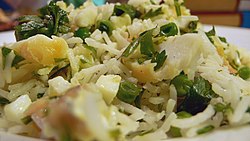 | |
| Place of origin | India and Scotland |
|---|---|
| Main ingredients | Rice, smoked haddock, eggs, parsley, butter or cream |
Kedgeree (or occasionally kitcherie, kitchari, kidgeree, kedgaree, kitchiri, khichuri, or kaedjere) is a dish consisting of cooked, flaked fish (traditionally smoked haddock), boiled rice, parsley, hard-boiled eggs, curry powder, lemon juice, salt, butter or cream, and occasionally sultanas.
Contents
The dish can be eaten hot or cold. Other fish can be used instead of haddock such as tuna or salmon, [1] though these are not traditional. In Scotland, kippers are often substituted for the smoked haddock. [2] [3] [4]
In India, khichari is any of a large variety of legume-and-rice dishes. These dishes are made with a spice mixture designed for each recipe and either dry-toasted or fried in oil before inclusion. This dish was heavily adapted by the British, resulting in a dish almost unrecognisably different from the original khichari.